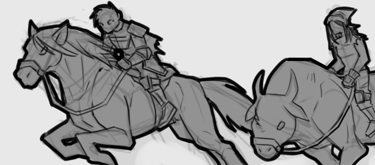

Chapter 3.7 Mounts
Taming and Mounting (Updated on 11/18/2025 version 1.2 - Pending another review for terms "Taming vs Domestication")
Nature based players live their lives according to nature's natural tendencies. However, other players will want to tame/domesticate creatures to fit their goals and needs. Mounting creatures is seperate from the wildlife claim, and is a simple bond to control and command their creature using breaking methods. These are typically horses and oxen, however, players can break other creatures when enough skill and resources can be applied.
Domestication Through Shards
Players can domesticate animals through creature shards found in the wild. Some will remain on trees, others will fall at the base of the tree. Shards still on the tree will have weaker stats than ones on the ground, as they haven't fully developed yet. Domestically leaning animals are often already tamed when summoned through shards. Otherwise, taming is still needed for more wild creature.
Taming Methods - Breaking Mechanics
Players can mount a creature and attempt to stay on it long enough exhausted. Horses and oxen can be broken/mounted without specific skills, but other creatures will need specific skills or items to be unlocked, discovered, or crafted. Character traits and skills can make breaking a creature easier. In an exhausted state, a creature will not attack, and can be lead somewhere with a tether. Some creatures will require this to be done multiple times before they are domesticated. If a creature successfully forces a player to be bucked off, it will take longer for that player to tame them. A trait/skill can signal if they are losing their grip, and retreat early for to retain some success.
Leading with Tethers
Players can lead a tamed or untamed creature with a rope, chain, or other types of tether leads. However, if not fully domesticated, they may attack or flee when they exit exhaustion. When a creature attempts to flee, if strong enough, a player can reel them back in and re-enter the breaking mechanic.
Shepherd Staffs
Players can lead domesticated creatures, with shepherd staffs. Shepherd staffs work within a radius and allow multiple animals to move with a player as if they were tethered. Shepherd staffs are linked to a property claim's fenced area and/or creature shelter. Thus, they will only work on creatures that are your owned property. If an animal leaves the affected radius for too long, the tether will wear off, and they will start wandering on their own, and will need to be re-linked. A shepherd staff's radius is based on the crafting stats and complexity.
Resist Domestication Traits - Unpredictable Fleeing / Unpredictable Aggressiveness
Some creatures will have traits that are common for the creature to have, or may be rarely applied. Some traits will cause creatures to act as if they are not fully domesticated, often times fleeing as if startled, or attacking the owner as if untame. Some creatures and all monsters are not intended to be domesticated and can attack other players, livestock, and construction. Land claims will default certain interactions as crimes if monsters are not intended to be a staple creature of an outpost. (More about crimes and outposts in a future section.)
Trust Levels
Mounts newly tamed will have a low trust level. Often moving erratically on their own, or act aggressively in certain contexts, or buck randomly. As players care for the creature, they will gain more trust, and will become more obedient. Overtime they can lose obedience if they are not a domestic leaning, like predators and monsters. Land claim controls can lessen or negate this (in some contexts, some monsters will always revert back to wild). Some resist domestication traits can be negated with high trust.
Communal Trust
Players and NPC with the right skills/traits and property controls can transfer trust to a new owner, allowing ranchers to tame and breed mounts to then sell to a player or NPC. NPC will more commonly ranch common creatures like horses and oxen, but may also sell more unique mounts based on world events and resource availability.
Contextual Trust
Creatures, monsters, and other entities will only trust players based on their current legacy and alignment. For example, a player will not be able to mount a creature they have killed a ton of, unless they have a skill/trait/blessing that overrides this.
Larger Taming Methods
Players have the ability to construct turrets that have harpoons with ropes or chains to hold down a large creature. These can be mounted on the ground, structures, and vehicles. The creature will be locked in place until the binds can break, or the machines themselves are broken. Monsters will use minions, long ranged attacks, or can walk up to poorly placed turrets, if not restrained enough in the opposite direction. Players will need to strategize the turret locations. When a monster reaches exhaustion, they can be open to taming, but will have special traits to make this difficult. Some traits will refuse domestication until certain contexts are met.
However, large creatures will not be directable like a normal mount, when riding. They will continue to move of their own accord, and players can remain on them without being forcefully thrown off. Large creatures will need to persistently be retamed. However, there are other usages:
Large Creature Taming Will Cause a Monster To:
Not attempt escape when tethered, caged, harpooned, or throned
Can be used for directing large creatures into arenas
To be kept and killed later for specific offerings and rituals
Sent to other locations during wartime with enough war/faith culture
Lead players to other locations
Crafting optional constructions to carry more players
Kept a living trophy to flex a community's organization and strength
For nature base characters to build fortresses upon if fortress founder has enough favor and maintains favor
Unlock artificial nest construction as an throne for for worship
Monster demands is based on typing and size to stay tamed
Allow the ability to do harvests for resources that grow on them
Summoning a Mount
Players can construct a Shepherd Shard to retrieve a mount into a shard to keep in their inventory. However, depending on the stats and complexity of the craft, the radius of the range will change. Thus players and NPC can sell animals as is, or in their shard inventory state. Monsters can only rarely, and under certain circumstances, be kept in shards for a limited amount of time. When they burst through, they will often attack or flee.
Tethering Mounts
Players can tether mounts to public and private posts to keep them in place. Some creatures will wander less like horses and oxen, but other creatures may move around, graze, or hunt, if not tethered. Monsters will almost always wander and are unlikely to accept tethering. Player unlocked tech and skills can make monsters more manageable.
Purchased Mounts - Nope
Players will not be able to purchase mounts with real life money. All mounts must be discovered, tamed, and rode within the context of the player character's ability and the world's context to generate the creature.
Now that you own some creatures, find out what they can be used to create.
